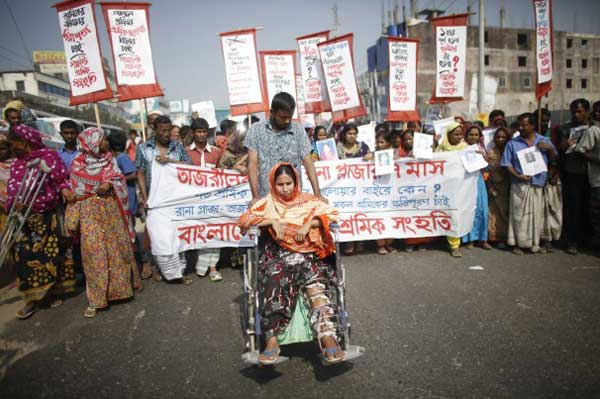The Washington Post on 27 November 2013 ran an article on the aftermath of the Rana Plaza Tragedy – a building hosting five garment factories in Savar, Dhaka caved in claiming the lives of 1,132 workers in April 2013. Dr Khondaker Golam Moazzem, Additional Research Director, CPD opined on different aspects of the extreme aftereffects, some of which are yet to be resolved.
Reblogged from The Washington Post
Changes to Bangladesh garment industry grind ahead, but slowly

By Howard Schneider, Published: November 27
Among the more useful things that the international community has done for Bangladesh since a textile factory collapse killed more than 1,100 workers this past spring was to send DNA kits.
They came courtesy of the U.S. government and helped identify dozens of bodies crushed in the collapse of Rana Plaza in April, said Khondaker Golam Moazzem, a research director at the Dhaka-based Center for Policy Dialogue.
“We did not have the capacity locally to do large numbers of DNA matches, so it has been difficult to identify all the bodies from the collapse,” said Moazzem
Families are still waiting for compensation. Promised building inspections are still to be done. The government has yet to agree on the details of new safety regulations, and a disputed election threatens to slow the progress further.
But at least the dead could finally be named.
“We did not have the capacity locally to do large numbers of DNA matches, so it has been difficult to identify all the bodies from the collapse,” said Moazzem, citing just one of a series of obstacles in the effort to improve working conditions in Bangladesh’s massive textile industry and to help families devastated by the Rana Plaza tragedy.
Much has been set in motion in the months since the building collapse and a fatal fire at another factory focused international criticism on the country — perhaps foremost an agreement by major retailers to conduct their own inspections of Bangladesh factories and make sure needed renovations are made.
But change on the ground has been slow, said Moazzem and others who have followed the process. There is concern that as the scope of the needed factory renovations becomes clear, owners may resist when they are asked to shut down plants for weeks at a time or help finance installation of new safety systems. A round of strikes and sporadic violence ahead of January elections have sparked worry among some activists and others that the political system could become paralyzed at a time when the government is supposed to tighten oversight of an industry that has far outgrown the local ability to enforce standards.
“This will not be cleaned up in 20 weeks,” said Scott Nova, executive director of the Workers Rights Consortium, a group that inspects factories around the world where college and university apparel is made.

The building collapse galvanized international attention on Bangladesh, one of the world’s major textile centers and home to an estimated 5,000 or more factories attracted there by low wages and a large supply of available labor. The country has supplanted even China as a preferred location for the textile plants that have helped keep clothing cheap in the developed world and boosted the fortunes of chains from Wal-Mart in the United States to H&M and Zara in Europe.
But change on the ground has been slow, said Moazzem and others who have followed the process
The pressure on the country to improve working conditions at the plants has been intense and included a U.S. cancellation of preferential trade privileges for some Bangladeshi goods. The retail clothing industry — stung by the association with substandard wages and repeated industrial accidents — pledged to do more and, by many accounts, is following through.
Two separate groups were established — one involving mostly European clothing chains and the other including major U.S. brands and companies. Last week the two agreed on a common set of inspection standards, an important step to ensuring that Bangladesh’s factories meet minimum criteria for safety measures such as the placement of emergency exits, sprinkler systems and fire alarms. Their inspections will eventually cover about 2,000 of the country’s textile plants.
Companies in the U.S. group have begun sending in engineers to inspect factories with which they have contracts, while the European consortium has hired a chief inspector and is recruiting a team of engineers that will begin work next year.
“The fact that we have inspectors in factories is important,” Nova said. That marks a change from recent years, he said, when retailers left safety and workplace issues to the factory owners rather than use their own financial leverage to improve conditions.
But not everything has gone smoothly. A new labor law has made it easier to establish worker safety committees in factories and boosted registration of unions. Yet overall it “fell short of expectations” that Bangladesh would bring its labor code into line with international standards, concluded a recent staff report from the U.S. Senate Foreign Relations Committee.
A separate governmental effort to finish a new set of regulations for the garment industry has taken longer than expected, and there is concern that the upcoming elections may put it off even longer.
The inspections backed by European and U.S. retailers may improve conditions over time, but more durable change will require the Bangladeshi government to build a regulatory system that can keep pace with the industry, said Kim Elliott, a researcher at the Center for Global Development who recently visited the country.
“The whole premise of improving the labor system depends on building government, as well as industrial, capacity,” Elliott said. “Whether that can happen in the current environment is questionable.”

